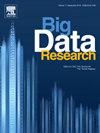Bipartite graph partitioning and spatial bootstrapping methods: A case study of innovative startups
IF 4.2
3区 计算机科学
Q2 COMPUTER SCIENCE, ARTIFICIAL INTELLIGENCE
引用次数: 0
Abstract
Innovative startups are the source of innovation and technological development; therefore, understanding their behavior can help better recognize the business organization's direction. This paper introduces a new method for clustering innovative startups using bipartite graph partitioning combined with spatial bootstrapping, improving clusters' accuracy and interpretability. Recent advancements in clustering techniques have introduced ensemble or consensus clustering methods, which aim to merge multiple clustering results into a superior outcome. A key challenge in this field is effectively integrating diverse clusters, and one promising solution involves utilizing graph formalism and partitioning strategies. By leveraging advanced graph partitioning techniques, we transform the task of partitioning the ensemble graph into a community detection problem. Our methodological approach improves the traditional method of bipartite graphs used in cluster ensembles by implementing the state of the art biLouvain algorithm. We also focused on techniques that could be used to increase the interpretability of the clusters themselves and how they can be used to obtain insightful information from the data. The proposed methodology was applied to a dataset of technologically advanced new businesses, located in the Lombardy region and recorded as innovative startups in the special section of the Italian Chambers of Commerce's Business Register.

二部图划分与空间自举方法:以创新创业公司为例
创新型创业公司是创新和技术发展的源泉;因此,了解他们的行为有助于更好地认识企业组织的方向。本文提出了一种利用二部图划分和空间自举相结合的创新创业公司聚类方法,提高了聚类的准确率和可解释性。聚类技术的最新进展引入了集成或一致聚类方法,其目的是将多个聚类结果合并为一个更好的结果。该领域的一个关键挑战是有效地集成不同的集群,一个有前途的解决方案涉及利用图的形式化和划分策略。通过利用先进的图划分技术,我们将集成图的划分任务转化为社区检测问题。我们的方法通过实现最先进的biLouvain算法,改进了聚类集成中使用的传统二部图方法。我们还关注了可用于提高集群本身的可解释性的技术,以及如何使用它们从数据中获得有洞察力的信息。拟议的方法被应用于伦巴第地区技术先进的新企业数据集,这些企业被记录为意大利商会商业登记簿的特别部分中的创新初创企业。
本文章由计算机程序翻译,如有差异,请以英文原文为准。
求助全文
约1分钟内获得全文
求助全文
来源期刊

Big Data Research
Computer Science-Computer Science Applications
CiteScore
8.40
自引率
3.00%
发文量
0
期刊介绍:
The journal aims to promote and communicate advances in big data research by providing a fast and high quality forum for researchers, practitioners and policy makers from the very many different communities working on, and with, this topic.
The journal will accept papers on foundational aspects in dealing with big data, as well as papers on specific Platforms and Technologies used to deal with big data. To promote Data Science and interdisciplinary collaboration between fields, and to showcase the benefits of data driven research, papers demonstrating applications of big data in domains as diverse as Geoscience, Social Web, Finance, e-Commerce, Health Care, Environment and Climate, Physics and Astronomy, Chemistry, life sciences and drug discovery, digital libraries and scientific publications, security and government will also be considered. Occasionally the journal may publish whitepapers on policies, standards and best practices.
 求助内容:
求助内容: 应助结果提醒方式:
应助结果提醒方式:


